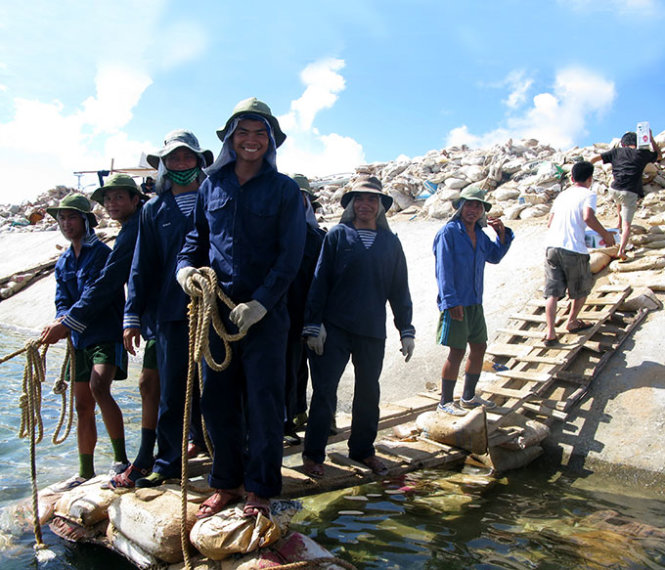Tuoi Tre News presents photos of the sappers who contributed massively to the construction of infrastructure in the Truong Sa (Spratly) archipelago during the 1970s and 1980s, with many killed in the process.
During the periods, the sappers of Regiments 131 and 83 worked tirelessly to perform such tasks as building and repairing houses, roads and bridges, and laying and clearing mines in Truong Sa, which is administered by the south-central province of Khanh Hoa.
They worked under extreme conditions, risked their own lives and braved omnipresent enemy threats, insiders recalled.
Tuoi Tre (Youth) newspaper reporters paid a recent visit to Le Nhat Cat, chief commander of the first sapper group tasked with building houses and facilities in Truong Sa.
In late April 1976, Captain Cat, leader of Battalion 3 under Naval Sapper Regiment 83, headed for the archipelago along with almost 70 military construction officers and soldiers.
Cat’s regiment came into being in late 1975 and became a spearhead unit in constructing roads, piers and airports.
“Shortly after Vietnam was reunified in April 1975, the war-torn country incurred tremendous difficulties, including a scarcity of fuel,” he recalled.
“Very few ships, which were small cargo freighters used during wartime, went to Truong Sa then. The ships swayed and jerked fiercely on rough seas.”
Another daunting hurdle was the shortage of construction materials, such as bricks, Captain Cat further recalled.
Sixty-four officers and soldiers of the Vietnam People’s Navy were killed in a battle against Chinese forces to safeguard Gac Ma Island, part of Truong Sa, on March 14, 1988.
Among the perished were 26 officers and soldiers of the Naval Sapper Regiment 83.
One day after the bloody battle, Company 12 under Regiment 131 was dispatched to Truong Sa to rebuild two houses on the archipelago’s Da Lon Island.
This was the regiment’s first trip to the archipelago.
Colonel Nguyen Kieu Kinh, of the Navy’s Political Department, who was part of the construction team then, confirmed that all these soldiers and officers were willing to die for the country.
“On the way to the archipelago, there were times when the enemy’s reconnaissance planes were flying at dangerously low altitudes and pilots were seen quite clearly,” he divulged.
At other times, Chinese vessels were only one or two nautical miles from his team.
“These imminent threats failed to deter us. We were ready to detonate one ton of explosives on board to avoid being captured by the enemy in case of confrontations,” Pham Van Minh, another team member, revealed.
Nguyen Van Can, one of the sappers stationed on Truong Sa’s Len Dao Island in early October 1988, said that with no speedboat available, he and his comrades had to build rafts and load them with construction materials. They could not push them to the island until midnight.
“When we were building houses on Truong Sa’s Sinh Ton Dong Island, a storm battered the place. Ninety sappers stayed put in a makeshift shelter, which was shaking violently in the storm, and had tiles blown off,” he recalled.
Below are some of the archival photos which Tuoi Tre reporters collected during their recent visits to the first generation of Truong Sa sappers.

Sappers would constantly work in extreme conditions including unforgiving weather and rough seas.

One of the houses on a submerging island which were built by the first generation of sappers in April 1988 is seen in this file photo.

This rare photo speaks volumes about the sappers’ silent yet massive contributions: they immersed themselves in water for hours, moving old concrete poles and clearing the sea surface to get ready for the construction of a new house.

The sappers perspired profusely and even bled moving each of the rock cubes from ships to the island to cement the country’s sea “corridor.”

Admiral Giap Van Cuong is seen checking the sovereignty pole on a submerging island in Truong Sa in 1988.

Graves of the sappers who died in action in Truong Sa

Deputy Admiral Le Van Xuan, former commander in chief of the Navy’s Political Department, is seen at a house built by the first generation of sappers in Truong Sa.

A house at Thuyen Chai B is pictured in May 1988
Like us on Facebook or follow us on Twitter to get the latest news about Vietnam!




















































